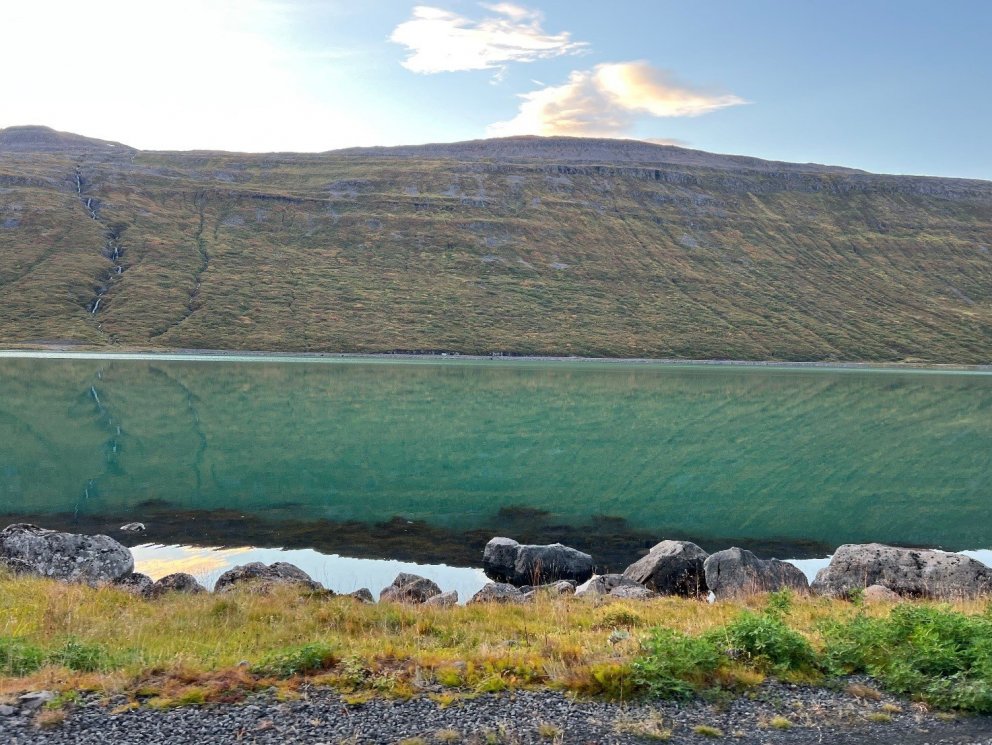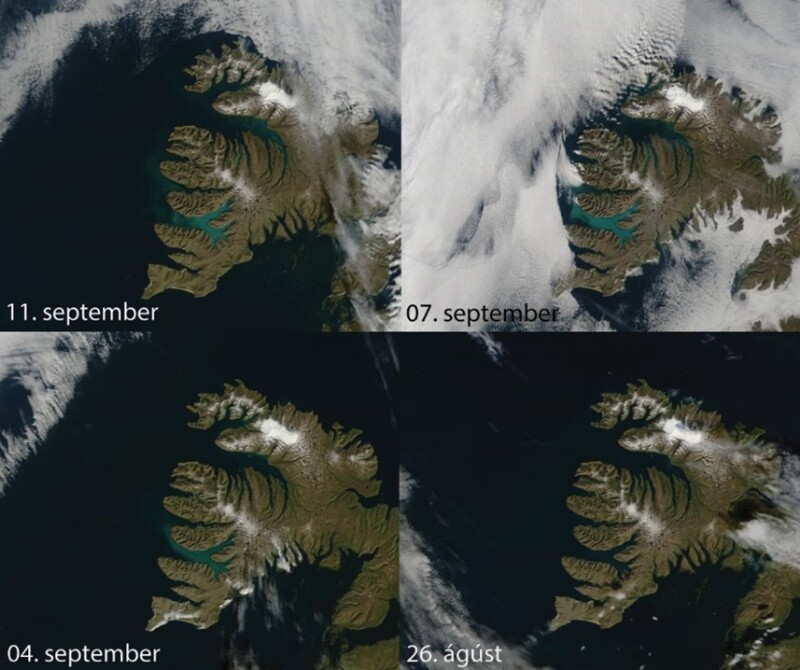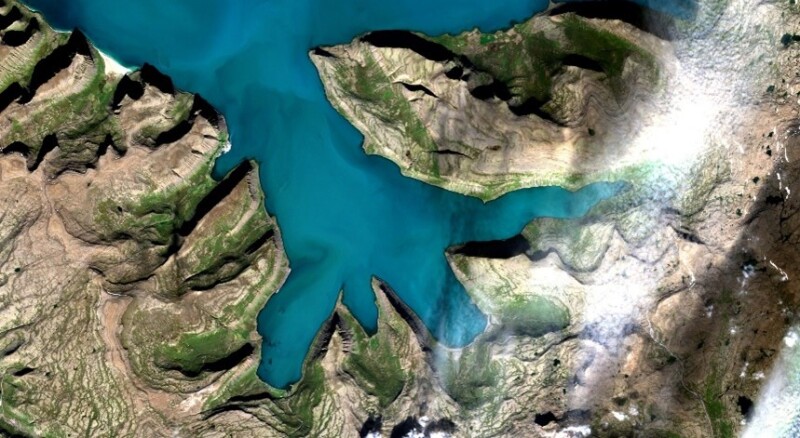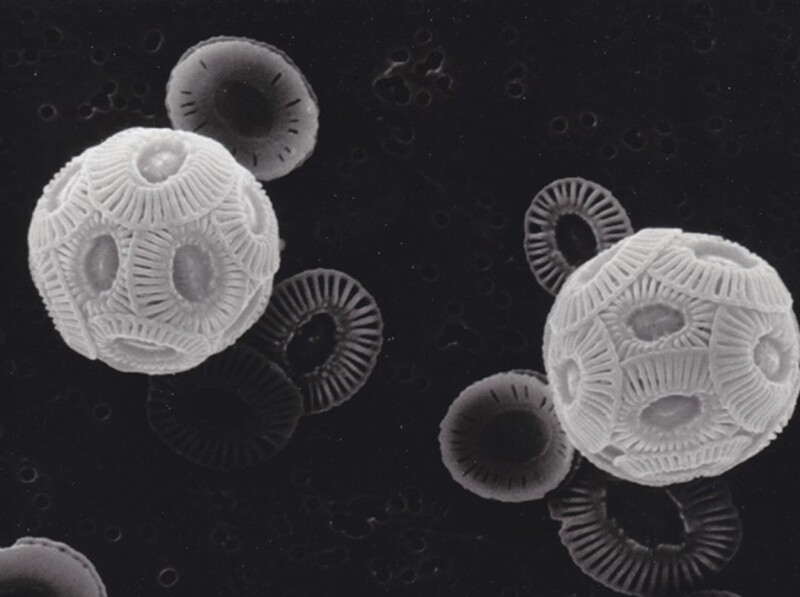- Research
- Fish tagging
- Lumpfish research
- Oceanography
- Seabed mapping
- Arnarfjörður
- Drekasvæði
- Ísafjarðardjúp
- Jökulbanki
- Jökuldjúp
- Kolbeinseyjarhryggur and adjacent area
- Kolluáll
- Langanesgrunn
- Látragrunn
- Nesdjúp
- Reykjaneshryggur and adjacent area
- Selvogsbanki
- South of Selvogsbanki
- South of Skeiðarárdjúp
- South of Skerjadjúp
- Southeast of Lónsdjúp
- Southwest of Jökuldjúp
- Suðausturmið
- Suðurdjúp
- Vesturdjúp
- East of Reykjaneshryggur
- Vestfjardarmid
- Seal research
- Whale Research
- Advice
- About
Coccolithophorid bloom in the Westfjords of Iceland
19. September 2022
 Algae bloom in Hestfjordur on September 9. Photo Ingvar Jakobsson.
Algae bloom in Hestfjordur on September 9. Photo Ingvar Jakobsson.
The sea surface in Arnarfjörður displayed green coloring in the beginning of September (Fig. 1). Because the timing and locations are unusual for the prime suspect, a phytoplankton bloom, we asked for samples and examined the sea surface water by microscopy September 5, 6, and 7. The phenomenon is indeed an intensive bloom, dominated by a small (5-7 µm) coccolithophorid named Emiliania huxleyi. Observing the event by satellite imagery (https://worldview.earthdata.nasa.gov) the bloom has in the past days spread to the neighboring fjord Dýrafjörður and another bloom is occurring in Hestfjörður. The cell counts from Arnarfjörður (Tjaldanes and Fossfjörður) was approximately 4.7 and 6.3 million cells/L, September 5 and 6, respectively. In Hestfjörður the blooming event occurred a couple of days later, on September 9 we observed < 500.000 cells/L. The concentration does not reach the threshold classifying a bloom event of coccolithophorids, 1 million cells/L. However, we suspect the lower cell counts to be because the sample was taken close to the shore and not representative for the height of the bloom in the water.


Fig. 1. Satellite images of algal blooms over a two-week period show the development and distribution of the bloom in the Westfjords. The lower picture shows the flower at Bíldudal in close-up. Photos: https://worldview.earthdata.nasa.gov, Ingibjörg Jónsdóttir, University of Iceland.
As the bloom develops the surface displays veils of lighter color and the surface appears milky, this is a result of the cells shedding its coccoliths, when regenerating new ones. The cells are characteristic under the microscope (Fig. 2) and the blooms blue green color and milky vails is visible from land and outer space. Emiliania huxleyi is known to have significant impacts on both calcium and carbon cycling. The cells bind calcium from the surrounding dissolved calcium and bicarbonate in the water and the sinking of cells and coccoliths eventually building chalk reservoirs in the seabed. As other phytoplankton, Emiliania huxleyi uses atmospheric CO2 to photosynthesize, the species can be effective as a carbon sink.

Figure 2. Emiliania huxleyi protozoa and calcareous plates. Micrograph GEOMAR, Lennard Bach.
To MFRI knowledge and records we have not seen a bloom of this sort starting inside an Icelandic fjord in September. Emiliania huxleyi blooms have been observed annually by satellite, offshore south and southwest of Iceland in spring and summer the past few decades. Sporadically these blooms have migrated north, but the ongoing bloom is seemingly not a result of such an event.
The favorable conditions recoded for mass growth of Emiliania huxleyi around Iceland is in connection with inflow of warm and salty Atlantic water, with low nutrient levels and strong layering in the water column (see also in detail https://www.hafogvatn.is/static/research/files/fjolrit-139.pdf and https://www.hafogvatn.is/static/research/files/fjolrit-145.pdf). Blooms are known to occur following sunny and calm days, such as the condition were in the Westfjords. We can speculate that cells of Emiliania huxleyi have been dwelling in low numbers in the sea surface or the seabed and migrated to the surface layers to utilize the favorable condition.
Emiliania huxleyi does not produce toxins and is not harmful to the environment, there should not be a reason to conclude that this bloom will be harmful to the ecosystem or the aquaculture in the area.
